Tool Test: Jointer/Planer Combo Machines
Wide jointer, heavy-duty planer, one small footprint
Synopsis: Combination jointer/planers, widely used in Europe but still relatively rare in the United States, maximize shop space. Instead of buying a large, pricey jointer and a separate plane, a woodworker can choose a jointer/planer that uses the same cutterhead for both operations. But does the combination mean you’ll have to sacrifice performance? Roland Johnson tests four moderately priced jointer/planer models to answer the basic questions: How different are they, and how well do they work?
Models tested include the MiniMax USA FS 30, Hammer A3 31, Rojek MSP 315, and Rojek MSP 310 M.
From Fine Woodworking #190
Working in a small shop can be a challenge, given the large tools woodworkers tend to accumulate. I’m always rearranging my tablesaw, bandsaw, jointer, drill press, workbenches, and dust collector to optimize space and give myself room to work.
Combination jointer/planers— commonplace in Europe but still a rarity in the United States—maximize available space because they use a single cutterhead for two operations. The jointer bed typically is designed to swing up and out of the way, providing access to the planer bed below. An integrated dust hood pivots to accommodate both operations.
These machines also present some questions: Do you pay a premium for a combo, compared with separate machines? Do you sacrifice performance, or is a combo machine equal to the sum of its parts? How different is a combo from the machines most of us are accustomed to using?
To answer those questions and others, I looked at the four jointer/planer combinations that are moderately priced and readily available. All use a 12-in.-wide cutter head, with jointer beds ranging from 50 in. to 59 in. long. Each manufacturer offers larger, pricier machines, but they are not practical for many hobbyists. One well-known brand, Laguna Tools, is not represented; its redesigned jointer/ planer wasn’t available in time for this review.
The basic questions, answered All four combo machines delivered excellent results in my tests. Using maple, white oak, and cherry, I face-jointed and edge-jointed long, wide boards without difficulty, and planed boards with no snipe. These combo machines don’t sacrifice performance, and they don’t command a steep premium. Costs range from $2,500 to $4,400, not much more than a pair of conventional machines. An 8-in. jointer costs as much as $1,700; a heavy-duty planer costs $800 to $1,200. A conventional 12-in. jointer—a behemoth next to these combos—costs about $4,000 all by itself.
How different are they?— Combos aren’t radically different from conventional jointers or planers, but it takes time to get used to them.
You have to change some shop practices to use these machines effectively. It’s much more productive to do all the jointing for a piece, then change over to do all the planing. Of course, sometimes you have to joint and plane a single piece, or joint an edge when the machine was last used in planing mode.
For the full article, download the PDF below:
Fine Woodworking Recommended Products

DeWalt 735X Planer


Rockler Dust Right 1250 CFM























Log in or create an account to post a comment.
Sign up Log in